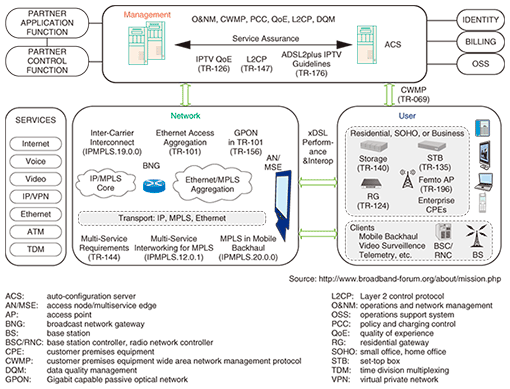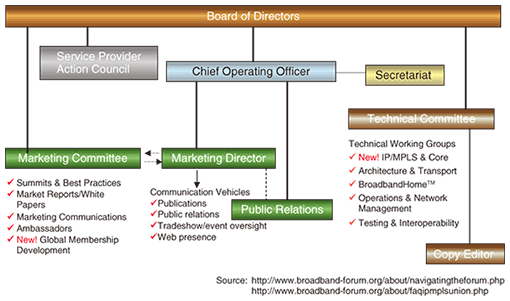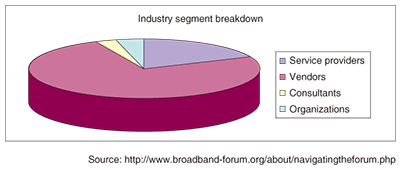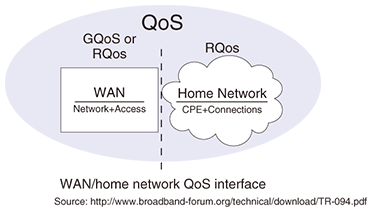 |
|||||
|
|
|||||
|
Global Standardization Activities Vol. 7, No. 8, pp. 51–57, Aug. 2009. https://doi.org/10.53829/ntr200908gls Standardization Trend of Home Networking in the Broadband ForumAbstractThis article gives an overview of the standardization of home-network-related topics in the Broadband Forum, a global consortium of approximately 200 leading industry players covering telecommunication equipment, computing, networking, and service provider companies. Established in 1994, originally as the ADSL Forum and later the DSL Forum, the Broadband Forum united with the IP/MPLS Forum in May 2009 to become the central body for next-generation Internet protocol (IP) network specifications.
1. IntroductionBroadband Internet access is a dynamic market all around the world and is the fastest growing area of the telecommunications sector. The leading broadband technology in the world is digital subscriber line (DSL), which holds approximately 66% of the broadband market share and is available in every region of the world. However, optical fiber deployments are increasing rapidly and they are a key component of IPTV (Internet protocol television) services, business services, and mobile backhaul of the future. The Broadband Forum [1] is a global consortium of approximately 200 leading industry players covering telecommunication equipment, computing, networking, and service provider companies. Established in 1994, originally as the ADSL Forum and later the DSL Forum, the Broadband Forum united with the IP/MPLS Forum in May 2009 to become the central body for next-generation IP network specifications (IP: Internet protocol; MPLS: multiprotocol label switching). Since 1994, the forum has developed more than 100 specifications ranging from DSL technology definitions to ways of delivering maximum effectiveness in broadband deployment and management. To show that it embraces work on all forms of DSL, not only asymmetric digital subscriber line (ADSL), the forum changed its name to the DSL Forum in 1999. Over the years, it expanded its work to address fiber architecture and management and digital home support to ensure that service providers can effectively deploy and manage their hybrid networks from a single IP-centric platform. To better represent this expanded scope, it changed its name to the Broadband Forum in 2008. Its logo is shown in Fig. 1.
Prior to uniting with the Broadband Forum in May 2009, the IP/MPLS Forum had a long parallel history of industry leadership. The IP/MPLS Forum started initially as three distinct forums—the ATM Forum, Frame Relay Forum, and MPLS Forum—and grew out of the evolution of IP transport technology (ATM: asynchronous transfer mode). 2. Broadband Forum activitiesThe Broadband Forum launched the BroadbandSuite™ in 2005, which grouped the technical work into solution sets, covering not only transport but also network management and digital home support. The current BroadbandSuite covers the three main solution sets of the Broadband Forum: network, management, and user-oriented specifications. The vision of the Broadband Forum is depicted in Fig. 2.
Some of the key network specifications to date are global test suites for ADSL, SHDSL (single-pair high-speed DSL), and ADSL2/2+. The performance/functional test suite for VDSL2 (very-high-speed DSL 2) should be completed by the end of 2009. These, along with bonding, will provide a complete portfolio of DSL technologies, and new work is looking at passive optical network access systems and end-to-end Ethernet standards. Work addressing energy efficiency test plans will assist the industry in establishing measurable adherence to global energy reduction commitments. Finally, new work around core and backhaul enhancements will ensure effective broadband convergence. Management work includes specifications for network management, policy control, and the operations support system. Some of the key areas that have been addressed are protocol-independent management models, broadband troubleshooting best practices, ADSL2+ profiles, Layer 2 control mechanisms, and current work on developing the policy control framework for fixed-line operators. In user-related work, establishing the remote management protocol for the digital home (TR-069 family of technical reports) was a major milestone because it is not biased toward any particular access method (known as being access agnostic). This is now broadly referenced by other organizations as the de facto standard protocol for global remote management. Adding object models for new device types as they emerged has empowered service providers to effectively provision and maintain the host of new applications and devices that come online. Current work moves beyond the home to address business service/device management as well as fixed mobile convergence requirements including femtocell access points. The organization of the Broadband Forum is shown in Fig. 3. A Service Provider Action Council provides an opportunity at each meeting for the providers to meet separately and discuss best practices, issues, and opportunities as well as to come together as a collective voice to identify the top initiatives for each year. With this input, the Broadband Forum stays aligned with real-world requirements and the Technical Reports (TRs) that are released have immediate application.
Each member company contributes to the work of the Broadband Forum by participating in technical and marketing working groups (WGs), sharing their knowledge, experience, and expertise to create common, agreed protocols, processes, and best practice recommendations for use by the industry and for standards and other related industry bodies. This work takes place at quarterly, week-long meetings and through the continuous activity of working groups. Through its marketing activities, which is an extensive, continuous global public and industry education campaign, the Broadband Forum also ensures a growing international understanding of the benefits of broadband. In meeting its core objectives, the Broadband Forum continues to establish essential and proven processes for broadband delivery that accelerate the delivery of broadband to the mass market and optimize the quality of service and customer’s experience. Technical Reports, Marketing Reports, and past IP/MPLS specifications are all available for use throughout the global industry and can be downloaded free of charge from the Broadband Forum’s website [1]. The Broadband Forum contributes to global industry standards by developing Technical Reports and through formal liaisons with global standards bodies such as ATIS (Alliance for Telecommunications Industry Solutions), ANSI (American National Standards Institute), ETSI (European Telecommunications Standards Institute), and ITU (International Telecommunications Union). Broadband Forum Technical Reports cover the technology itself, network operations and management, interoperability, and the integration of broadband technology into existing infrastructures. A breakdown of the Broadband Forum membership is shown in Fig. 4. Besides the approximately 200 leading companies covering the telecommunications, equipment, computing, networking, and service provider sectors, there are Associate members, which include academics and nonprofit organizations with an interest in broadband. The membership categories include Principal, Small Company Principal, Auditing, and Associates with annual membership fees of $9500, $4500, $3500, and $1000, respectively. Principal members have full rights to 1) attend all annual, general, and committee meetings of the Forum, 2) cast one vote each on all Forum issues, technical reports, and marketing reports, 3) access all working documents, contributions, technical reports, and meeting minutes, 4) run for the Board of Directors and Committee officer positions, 5) submit Technical Committee and Marketing Committee contributions, and 6) subscribe to all Broadband Forum email mailing lists. Small Company Principal Members must have had annual revenues under US$10 million; they get all the privileges of a Principal member. Auditing and Associate members have limited voting rights, officer position eligibilities, and contribution submission rights.
3. BroadbandSuite release programOver the last 15 years, the Broadband Forum has forged industry best practices and standards that have empowered service providers with the tools they need to optimize their broadband networks. Maturing from defining basic physical layer transport parameters to facilitating multimedia service delivery across broadband, the Forum’s work continues to be aligned with real-world broadband development and service provider requirements. Today, the Broadband Forum packages Technical Reports into distinct BroadbandSuite Releases that provide a roadmap for broadband solutions. Each new release builds on the earlier releases. Ultimately, the release program offers the industry a toolkit for broadband achievement.
BroadbandSuite 3.1 will add VDSL2 specifications soon. 4. Topics related to the home networkThe main study items related to the home network in BroadbandSuite are management for various kinds of customer premises equipment (CPE) and QoS control. 4.1 CPE management in the home networkAs shown in Fig. 5, the BroadbandHome Technical WG is studying the management interface between an auto-configuration server, which manages various kinds of CPEs in the home network, and CPEs. The CPEs to be managed include routers, such as a residential gateway, as well as various kinds of devices in the local area network (LAN). Lots of specifications are being produced for their configuration management, service provisioning, software/firmware management, state/performance monitoring and diagnostics. The auto-configuration server can be accessed by the OSS/BSS (operations support system, business support system), policy management server, and call center. It helps service and network providers to offer home network services.
The management protocol called CWMP (customer premises equipment wide area network management protocol) shown in Fig. 5 is specified by TR-069. Moreover, lots of data models are specified over this protocol to manage various kinds of CPEs. Data models for managing typical CPEs are listed in Table 1.
Of particular note, is the completion of the data model for Femto access points (Femtocell service) in April 2009 in the cooperation with the Femtocell Forum. One more feature is that the BroadbandHome Technical WG is studying ways to reflect IPv6 (Internet protocol version 6) requirements into TR-124 (Functional Requirements for Broadband Residential Gateway Devices), based on the IPv6 architecture being studied by the Architecture & Transport Technical WG. The data models for IPv6 are planned to be produced in the future, considering these activities. As shown in Fig. 5, CPEs can be categorized into two types: the residential gateway and LAN-side devices, such as a set-top box, that operate behind the residential gateway and communicate with WAN-side servers (WAN: wide area network). The residential gateway is directly managed by the auto-configuration server on the basis of TR-069. However, how to manage LAN-side devices behind the residential gateway remains a study item. TR-111 (Applying TR-069 to Remote Management of Home Networking Devices) specifies how to manage CPEs via the residential gateway where the network address translation function resides. Moreover, for the case where universal plug and play (UPnP) and so on are used between the residential gateway and the LAN-side devices, studies are in process to determine how to specify the managed devices’ proxy data model in the residential gateway. TR-069 as well as the data model documents of the Broadband Forum are well accepted by various standards bodies. Besides the Femtocell Forum, bodies such as the WiMAX Forum, HGI (Home Gateway Initiative), and ATIS are also planning to utilize these documents. 4.2 QoS control in the home networkThe service providers are studying how to provide QoS-guaranteed IPTV and/or VoIP. One of the reference documents for offering QoS over the end-to-end network is TR-101 (Migration to Ethernet-Based DSL Aggregation) produced by the Architecture & Transport Technical WG. This document specifies the whole architecture for providing IPTV services by multicasting and QoS functions in the IP/Ethernet-based network. Another reference document is TR-126 (Triple-Play Services Quality of Experience (QoE) Requirements), which specifies QoE requirements. On the other hand, TR-094 (Multi-Service Delivery Framework for Home Networks) should be referred to for QoS control in the home network, where the WAN-side traffic is merged with the LAN-side traffic. The QoS model for the home network depicted in TR-094 is shown in Fig. 6. Assuming that guaranteed QoS (GQoS) or relative QoS (RQoS) is used in the WAN, while RQoS is used in the home network, it describes the QoS mapping necessary for connecting the two networks. One should keep in mind that although the current TR-098 already specifies the QoS management in the residential gateway, the BroadbandHome Technical WG is studying it further in cooperation with HGI and the UPnP Forum for the purpose of incorporating detailed QoS management specifications into the next versions of TR-098 and TR-124.
Reference
|
|||||
















